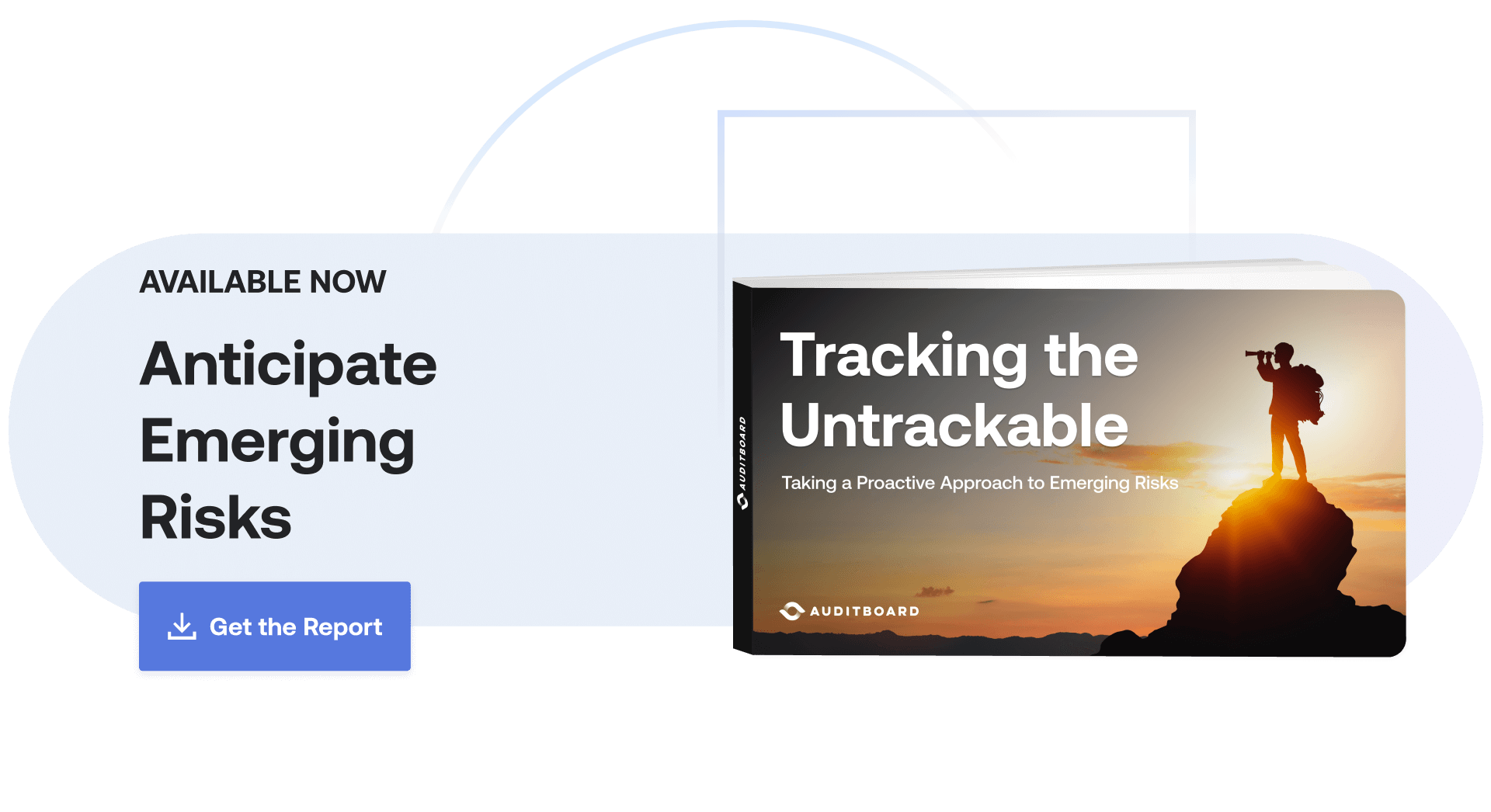
May 6, 2024 • 12 min read
Emerging Risk Trends in 2024: Are These On Your Radar Yet?
In the ever-evolving landscape of risk management, emerging risks often evade immediate detection or integration into an organization’s core risk management priorities and activities.
Gartner defines emerging risks as those whose effects have yet to be substantially realized in the enterprise. They are further characterized by their unpredictable evolution, which can be rapid and/or nonlinear. Recognizing and understanding emerging risks is an essential component of building a resilient business that can weather sudden interruptions. Neglecting to do so can cause missed opportunities for early detection and mitigation that ultimately conclude in costly oversights.
In the new guide Tracking the Untrackable: Taking a Proactive Approach to Emerging Risks, AuditBoard explores common reasons why many organizations have a reactive approach to emerging risks. This eBook then explores how organizations can transform their reactivity into proactivity through four important steps. Download the free eBook here, and continue reading below to learn the top emerging risk trends for 2024.
Emerging Risk Trends in 2024
Against a global risk backdrop of escalating political polarization and market effects from higher borrowing costs, organizations are facing a number of emerging risks in 2024. Some of the most pressing risks include mass generative artificial intelligence (AI) availability, cloud concentration risk, and regulatory changes around climate disclosures, cybersecurity disclosures, and the use of AI.
While there is no way to predict the exact velocity at which these risks will accelerate, the first step to mitigating emerging risks is to identify and understand them.
- Mass generative AI availability: The risk that massively available, generative AI rapidly surpasses the business’s ability to understand associated risks and opportunities. The root causes of this risk include immature corporate governance and regulations, rapid proliferation of diverse AI models and apps, and increased adoption of AI applications across industries. Potential consequences are:
AI-generated misinformation and disinformation. According to the World Economic Forum’s 2024 Global Risks Survey, 53% of respondents believe AI-generated misinformation is a risk likely to present a material crisis on a global scale in 2024.
Negative impact amplification: As the adoption of GenAI expands in organizations, the negative effects stemming from factual inaccuracies, hallucinations, biases, and potential copyright infringements within the outputs of large language models (LLMs) can become amplified across various organizational functions.
Threat of shadow AI. Forbes defines shadow AI as the unsanctioned or ad-hoc use of generative AI within an organization that is outside IT governance. Shadow AI exposes the business to many potential risks including data loss and exposure, violation of customer and employee privacy, and violations of regulatory compliance.
Business continuity threats: Inadequate governance of GenAI coupled with factors like shadow AI and dependence on a single AI vendor can expose the business to the risk of investment losses or the jeopardization of essential business functions and strategies. - AI-generated misinformation and disinformation. According to the World Economic Forum’s 2024 Global Risks Survey, 53% of respondents believe AI-generated misinformation is a risk likely to present a material crisis on a global scale in 2024.
- Negative impact amplification: As the adoption of GenAI expands in organizations, the negative effects stemming from factual inaccuracies, hallucinations, biases, and potential copyright infringements within the outputs of large language models (LLMs) can become amplified across various organizational functions.
- Threat of shadow AI. Forbes defines shadow AI as the unsanctioned or ad-hoc use of generative AI within an organization that is outside IT governance. Shadow AI exposes the business to many potential risks including data loss and exposure, violation of customer and employee privacy, and violations of regulatory compliance.
- Business continuity threats: Inadequate governance of GenAI coupled with factors like shadow AI and dependence on a single AI vendor can expose the business to the risk of investment losses or the jeopardization of essential business functions and strategies.
- Climate and ESG risk. In recent years, boards and executive leaders have encountered increasing demands from various stakeholders to integrate environmental, social, and governance (ESG) risks into their risk management strategies. The root causes of growing ESG risk include: rising global temperatures and increased risk of extreme weather events, growing political polarization, and increased social consciousness of organizational policies and actions that impact individuals, groups, and communities. Potential consequences include:
Supply chain disruptions as a result of extreme weather events. According to the World Economic Forum’s 2024 Global Risks Survey, 66% of respondents ranked extreme weather as the top risk most likely to present a material crisis on a global scale.
More regulatory requirements. New and upcoming regulatory changes, e.g., the SEC’s new rules on climate disclosures and cybersecurity disclosures, The Corporate Sustainability Reporting Directive (CSRD) in the EU, and the EU’s new AI regulation, will require audit, risk, and compliance teams to perform their work with more agility and efficiency to handle increasing compliance workloads.
Increased costs related to meeting ESG commitments. For example, the costs associated with a company’s decision to move away from fossil fuels or commit to becoming carbon neutral by 2030. More ESG projects will require more resources. - Supply chain disruptions as a result of extreme weather events. According to the World Economic Forum’s 2024 Global Risks Survey, 66% of respondents ranked extreme weather as the top risk most likely to present a material crisis on a global scale.
- More regulatory requirements. New and upcoming regulatory changes, e.g., the SEC’s new rules on climate disclosures and cybersecurity disclosures, The Corporate Sustainability Reporting Directive (CSRD) in the EU, and the EU’s new AI regulation, will require audit, risk, and compliance teams to perform their work with more agility and efficiency to handle increasing compliance workloads.
- Increased costs related to meeting ESG commitments. For example, the costs associated with a company’s decision to move away from fossil fuels or commit to becoming carbon neutral by 2030. More ESG projects will require more resources.
- Cloud concentration risk: The risk associated with over-dependence on one cloud provider for multiple business capabilities, where a potential service outage or failure can disrupt multiple aspects of the business. The root causes of this risk include increased regulatory scrutiny of cloud providers, limited choice of cloud vendors, and limited access to the advanced microchips necessary for GenAI and cloud services. Potential consequences include:
Operational disruption during service change. Regulator attempts to diminish cloud concentration within the technology sector can leave organizations vulnerable to rapid shifts in provider relationships that can upend their strategy and operations.
Wider “incident blast” radius. The broader the reliance of applications and business processes on a specific cloud provider, the wider the potential scope of impact if there is a service issue, which can exacerbate business continuity risk.
Vendor over-reliance, aka the “lock-in” effect. Excessive reliance on a single cloud provider can lock organizations into vendor-customized AI/cloud ecosystems, granting a third party substantial influence over the organization’s technological trajectory. - Operational disruption during service change. Regulator attempts to diminish cloud concentration within the technology sector can leave organizations vulnerable to rapid shifts in provider relationships that can upend their strategy and operations.
- Wider “incident blast” radius. The broader the reliance of applications and business processes on a specific cloud provider, the wider the potential scope of impact if there is a service issue, which can exacerbate business continuity risk.
- Vendor over-reliance, aka the “lock-in” effect. Excessive reliance on a single cloud provider can lock organizations into vendor-customized AI/cloud ecosystems, granting a third party substantial influence over the organization’s technological trajectory.
Empowering your organization with the necessary education and resources to effectively identify and manage emerging risks is a crucial step to staying ahead of these emerging risks. In fact, it should be a top priority for any risk leader and program. The best way to do so is by embedding emerging risks into your business’s existing risk monitoring infrastructure. Through creating a risk-aware culture that prioritizes equipping the business with resources for capturing, reporting, and tracking new risks, organizations can begin to develop a proactive approach to emerging risks. To learn more, download Tracking the Untrackable: Taking a Proactive Approach to Emerging Risks here.
You may also like to read


Staying in line: How to foster operational excellence across risk management

3 tips to navigate supply chain risk in the modern age

Cybersecurity risk assessments: A complete guide for building a risk program

Staying in line: How to foster operational excellence across risk management

3 tips to navigate supply chain risk in the modern age
Discover why industry leaders choose AuditBoard
SCHEDULE A DEMO




